Key Points
- A good core workout should be 15 to 30 minutes long and only needs to be done 3 or 4 times a week.
- To increase core strength: Perform loaded core movements for 3 to 5 sets of 5 to 10 reps.
- To build muscle, perform dynamic core exercises that flex and extend your abs for 8 to 12 reps in most cases.
- To gain endurance, perform isometric exercises, aiming to hold a static posture for up to a minute.
Want a ripped six-pack? Yeah, us too. But here’s the thing — your core is more than your abdominal muscles. Looking great at the beach is all well and good, but robust and functional core strength is both visually striking and practical in and out of the gym.
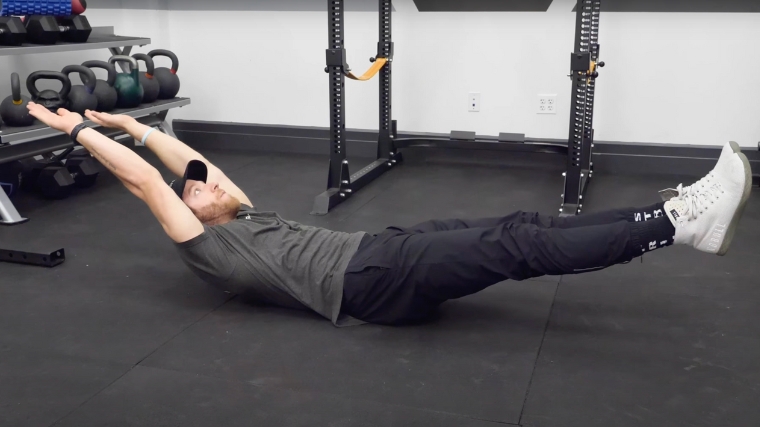
“Your core muscles go beyond your abs. The tissues that wrap around your torso help stabilize your midsection while you run, jump, play with your kids, lift weights, and everything else,” says BarBend Senior Writer and certified personal trainer Jake Dickson. The point is this: The best core exercises out there mimic the various movements you perform in your day-to-day life.
Here are 11 of our favorite core-training moves for you to cash in on, plus a few expert-verified core workouts:
11 Best Core Exercises
- Ab Rollout
- Dead Bug
- Suitcase Carry
- Pallof Press
- Overhead Carry
- Plank
- Hollow Hold
- Bird Dog
- Bear Crawl
- Hanging Leg Raise
- Cable Crunch
Recent Updates: Jake Dickson revised and expanded this list from 8 to 11 movements. The new list of exercises offers more variety and includes suggested modifications as well.
Editor’s Note: The content on BarBend is meant to be informative in nature, but it should not be taken as medical advice. When starting a new training regimen and/or diet, it is always a good idea to consult with a trusted medical professional. We are not a medical resource. The opinions and articles on this site are not intended for use as diagnosis, prevention, and/or treatment of health problems. They are not substitutes for consulting a qualified medical professional.
1. Ab Rollout

| Equipment Needed | Barbell and weight plates or ab roller, exercise mat (optional) |
| Muscles Worked | Abdominals, latissimus dorsi, hip flexors |
| Sets & Reps | 3-4 x 5-10 |
The ab rollout has you grip either a barbell loaded with round plates, an ab wheel, or an exercise stability ball and then extend your torso towards the ground. The ab rollout strengthens the core by lengthening it, which targets your eccentric strength.
“Ab rollouts are deceptively difficult,” says Dickson. “But they’re an amazing isometric core exercise no matter your goals.”
How To Do It
- Get on your knees and grip your equipment of choice with hands shoulder-width apart (unless you’re using an ab roller).
- Extend your hips towards the floor and let your chest sink forward toward the ground without overarching your lower back.
- The larger a range of motion, the harder the exercise, so shorten your ROM if you’re new to the exercise. Squeeze the lat muscles and pull yourself back to the starting position.
Modifications
- Make It Easier: Try to use a rolling item with a higher “elevation,” which will improve your leverage. The closer your hands are to the ground, the harder the move becomes.
- Make It Harder: Grab ahold of whatever you’re rolling with a narrow grip to test your shoulder flexibility as well.
2. Dead Bug

| Equipment Needed | Exercise mat (optional) |
| Muscles Worked | Abdominals, diaphragm, hip flexors |
| Sets & Reps | 2-3 x 15-20 |
Despite the dead bug exercise having a silly name, we love it for its simplicity and value. The idea behind the dead bug is that it teaches you to align your pelvis with your ribs, compress your abdomen and stabilize your trunk, all while moving your limbs in space. Dead bugs are a fantastic primer exercise before a strengh training workout, but they work wonders as a teaching tool for beginners as well.
How To Do It
- Lay on your back holding a kettlebell by the horns over your chest with arms extended.
- Lift your legs off of the ground and bend them at 90 degrees.
- Press your low back into the ground, take a deep breath in before you initiate the movement, and then exhale while simultaneously extending one leg and lowering the kettlebell until it gently touches the floor.
- Reverse the movement and then repeat with the other leg.
Modifications
- Make It Easier: Keep your non-working arm or leg on the ground rather than suspended in the air.
- Make It Harder: Hold a small weight in your non-moving hand to introduce some progressive overload and challenge your core.
3. Suitcase Carry
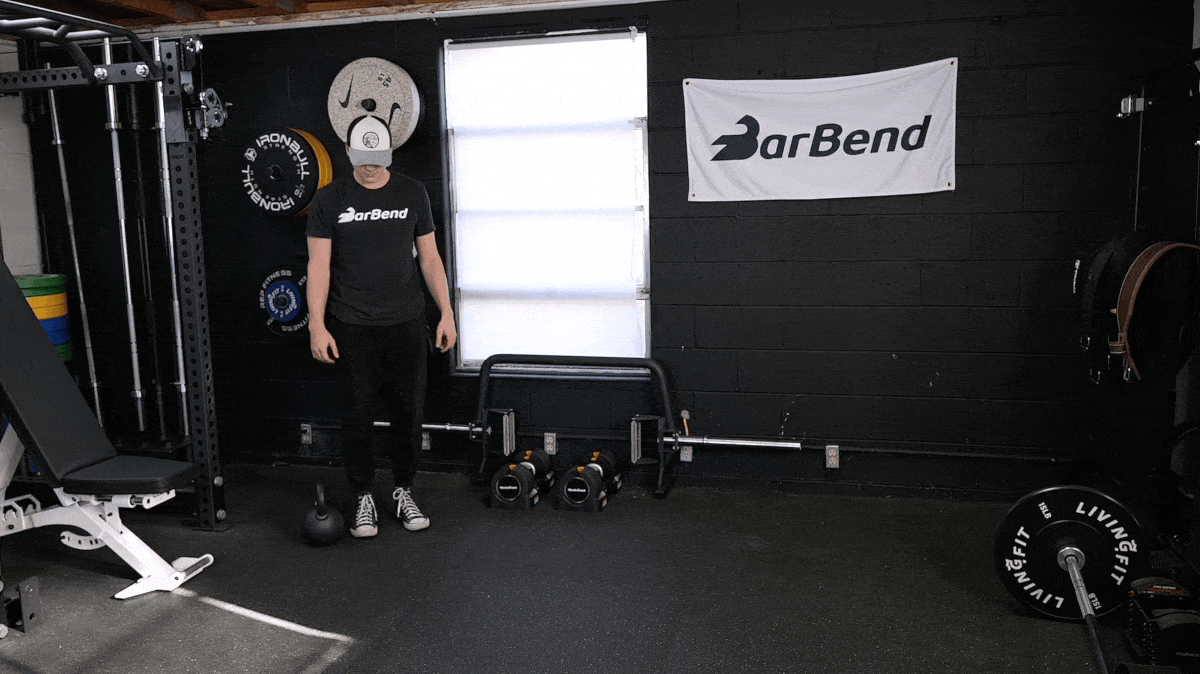
| Equipment Needed | Dumbbell, kettlebell, suitcase, or backpack |
| Muscles Worked | Traps, obliques, abdominals |
| Sets & Reps | Traps, obliques, abdominals |
The suitcase carry has all the benefits of farmer’s carries but this version will strengthen grip imbalances between hands. As far as weighted core exercises go, the lopsided load of the suitcase carry will encourage your core to develop anti-rotational strength. What does that mean? Well, you’ll strengthen the muscles that prevent you from wobbling or tipping from side to side.
How To Do It
- Start with a dumbbell or kettlebell that’s between about 25 percent of your body weight.
- Pick up the weight, crush the handle, and make sure you’re not tilting to one side or the other. A mirror can be helpful here.
- Walk slowly in a straight line, putting one foot in front of the other while swinging the opposite arm. Swap hands and repeat on the other side.
Modifications
- Make It Easier: Placing your non-working arm on your hip can help remind you to keep your pelvis and ribcage squared.
- Make It Harder: Try farmer’s carries with high-knee marches, rather than simply taking steps. This reduces the amount of time both your feet are in contact with the floor, enhancing the balance requirement.
4. Pallof Press

| Equipment Needed | Adjustable cable station, attachment of choice, or resistance band |
| Muscles Worked | Abdominals, obliques, glutes |
| Sets & Reps | 2-3 x 15-20 |
The pallof press, named after Physical Therapist Joseph Pallof, has become one of the go-to exercises for strengthening one’s anti-rotation ability.
“As the resistance tries to turn your body, your muscles work to prevent that rotation,” Meier explains. “I love this move for clients with osteoporosis in particular.”
[Read More: Best Home Gym Machines]
“This is a great functional core exercise for athletes because of the rotational element,” Dickson notes. “Golfers, baseball players, combat sport athletes and more can benefit from incorporating Pallof presses at least once a week.”
How To Do It
- Loop a light band around a pole or power rack at chest level.
- Stand perpendicular to the band, grab it in both hands, and take a few steps sideways until the band is taut.
- Squeeze your shoulder blades together, and then extend your arms forward. Do not let your torso or hips twist.
Modifications
- Make It Easier: Utilize a mirror if necessary to ensure you’re keeping your torso and hips squared.
- Make It Harder: Placing your feet close together will make this move more difficult to balance and stabilize.
5. Overhead Carry
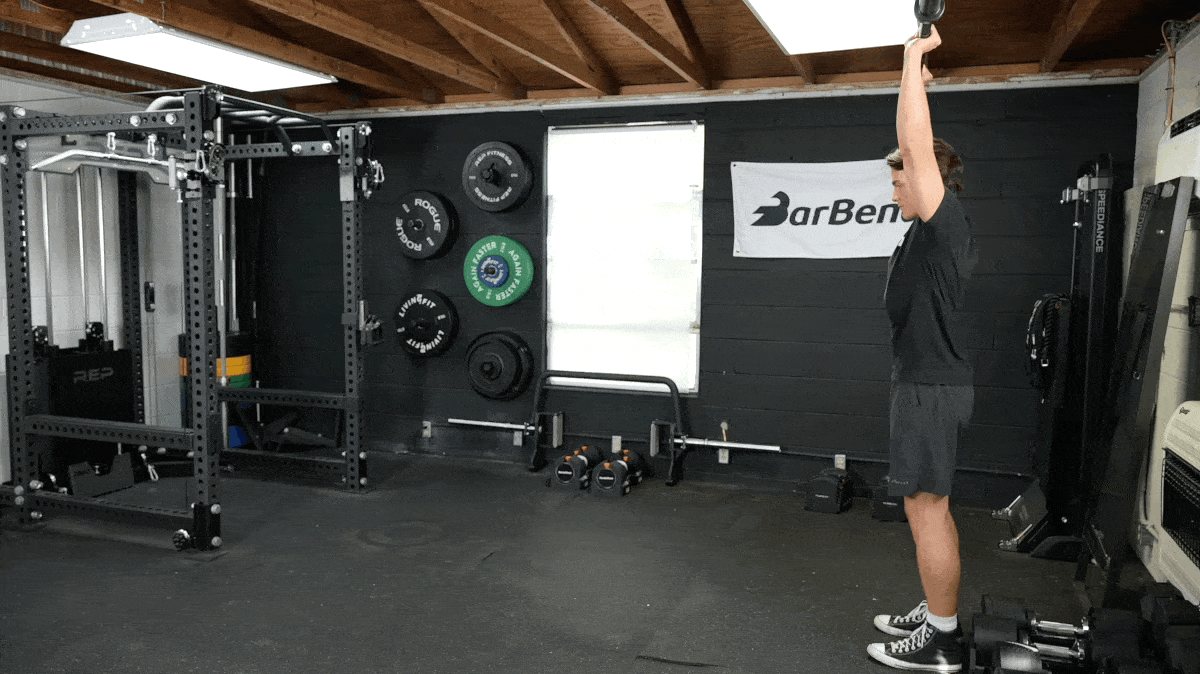
| Equipment Needed | Barbell and plates, dumbbells, or kettlebells |
| Muscles Worked | Upper back, abdominals, triceps |
| Sets & Reps | 1-3 x 10-20 paces |
The overhead carry is performed with either a barbell, dumbbells or kettlebells and a trap bar. The overhead carry will improve overhead stability for movements such as overhead press, squats, and clean and jerks and improve posture and gait.
[Read More: The Best Compact Exercise Equipment for Any Small Space]
“Overhead carries are a double-whammy: You build shoulder and upper-body stability while also engaging all of your core muscles,” says Meier.
How To Do It
- To do a barbell overhead carry, start by cleaning and pressing the weight overhead. Or, you can start with the bar loaded in a power rack.
- Ensure that your hands are set shoulder-width apart.
- Your biceps should be by your ears and your wrists should be straight and neutral.
- Take small, slow, and deliberate steps while looking straight ahead. If you need to turn around please do so slowly.
Modifications
- Make It Easier: Start by using an unloaded barbell held with a wide grip. One object is easier to stabilize than two, and the wide grip should be comfortable even if you don’t have shoulder flexibility.
- Make It Harder: For an extreme challenge, you can hold two objects of different weights in either hand and alternate which arm holds the heavier one each round.
6. Plank
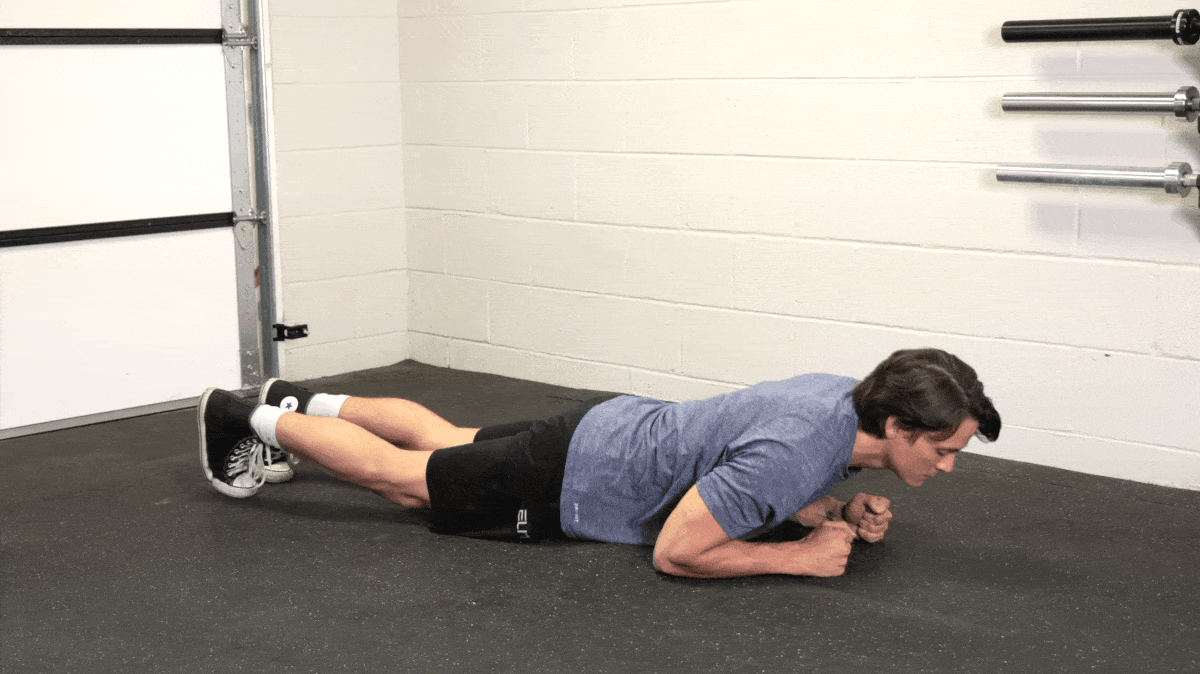
| Equipment Needed | Exercise mat (optional) |
| Muscles Worked | Abdominals, glutes |
| Sets & Reps | 3 x 30-90 seconds |
Planking is much more than a social media fad from the 2010s (Remember that? Good times). The plank exercise is one of our favorite teaching tools for anyone who needs to learn how to brace properly and engage their abdominals.
Planks also gain points as a practical core workout. They’re simple, easy to perform, and you can do them literally anywhere (including on top of a door frame, or a pool floatie, or…) to build up your endurance.
How To Do It
- Get down into a quadruped, on-all-fours position with your hands under your shoulders and your knees under your hips.
- Extend your legs so your knees are off the ground while dropping down to your elbows.
- Brace every muscle in your body from head to toe so your body forms a straight line.
Modifications
- Make It Easier: You can plank with your knees on the ground to reduce the amount of force gravity applies to your torso.
- Make It Harder: Try the “long lever” plank; Slide your elbows forward so they’re in advance of your shoulders. This increases the distance between your points of contact with the ground, making it more difficult to maintain your posture.
7. Hollow Hold
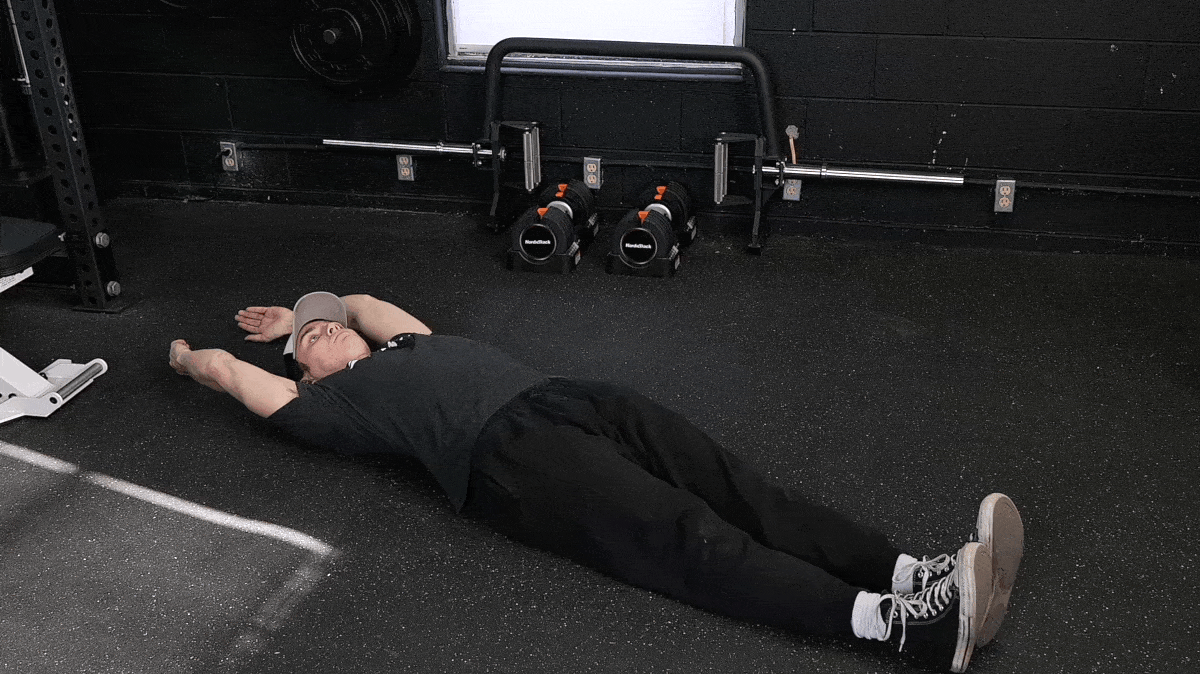
[Read More: The Best Leg Exercises for Muscle and Strength]
| Equipment Needed | Exercise mat (optional) |
| Muscles Worked | Abdominals, hip flexors |
| Sets & Reps | 2-3 x 15-30 seconds |
The hollow hold is like an upside-down plank. You balance on your butt, with your legs and arms extended to lengthen your center of mass. Since your core is at your center, it will be working the hardest to keep you stable and upright.
Aside from being an effective exercise, this is a great move as it requires little space and no equipment. You just need to use your body weight. What’s more, the hollow hold carries over nicely to other types of functional fitness training or strength sports.
How To Do It
- Lay on your back with arms extended overhead and legs pressed together.
- Lift your legs and upper torso off the floor. Hold this position.
- To perform the hollow rock, simply rock back and forth in this position, minimizing movement at the hip and shoulder joints.
Modifications
- Make It Easier: Hold your arms against your torso rather than behind your head.
- Make It Harder: Practice slowly rocking back and forth like a pendulum without changing your body position at all.
8. Bird Dog
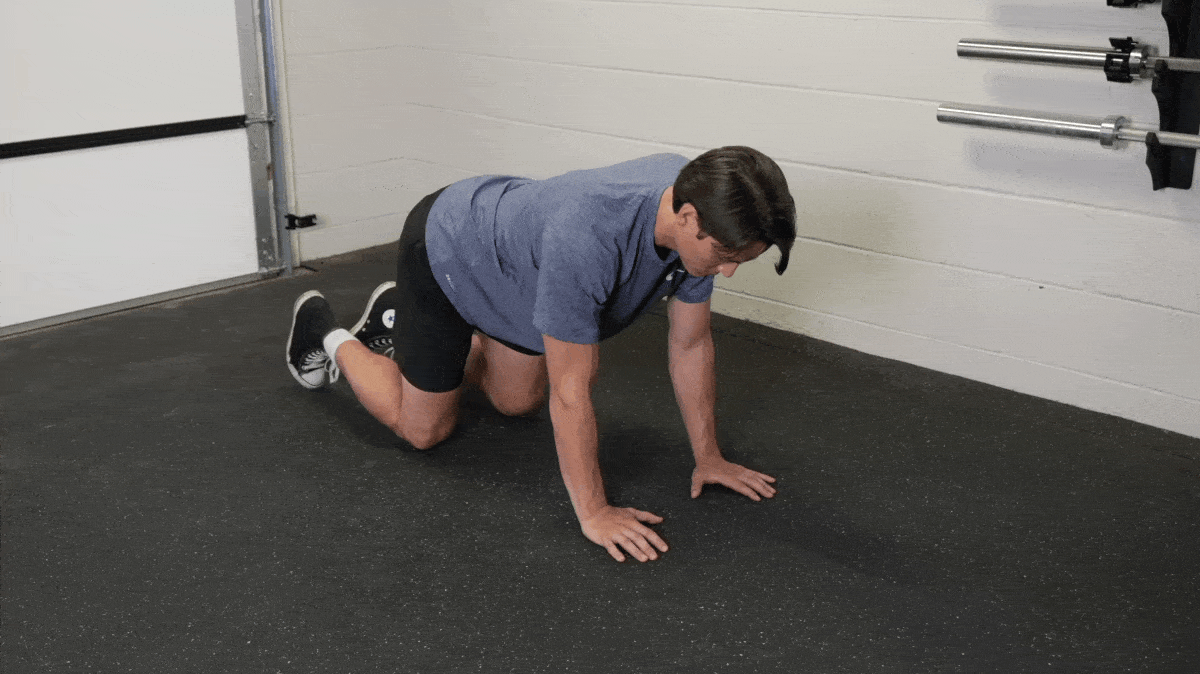
| Equipment Needed | Exercise mat (optional) |
| Muscles Worked | Core, hip flexors, shoulders |
| Sets & Reps | 2-3 x 10-12 |
“You can think of bird dogs as a slightly-harder dead bug,” says Dickson. “Instead of being on the ground on your back, you need to stabilize yourself on all fours, which is significantly harder.”
We like the bird dog for many of the same reasons we adore dead bugs. Bird dogs are a useful beginner core exercise that serves and trains your core’s main purpose — maintaining rigidity in your torso while you move your limbs.
How To Do It
- Get on all fours with your knees under your hips and your hands under your shoulders.
- From here, squeeze your core tight and then lift your right arm and left leg off the floor just a hair.
- Extend your leg out behind you while raising your arm forward, pointing straight ahead.
- Return your hand and foot to the starting position, then perform the same movement with the opposite limbs.
Modifications
- Make It Easier: Lift one leg or arm at a time, rather than moving both simultaneously, which takes more coordination.
- Make It Harder: You can wear ankle weights or hold onto a pair of light dumbbells to introduce some extra load.
9. Bear Crawl

| Equipment Needed | n/a |
| Muscles Worked | Abdominals, hip flexors, upper back, arms |
| Sets & Reps | 2-3 x 10-20 “steps” |
You might notice a lot of animal-inspired core exercises on this list. That’s by design — movements like the bear crawl help you get active while also strengthening your core. We like bear crawls because they’re just plain fun, but you can also use them to add a bit of dynamic stability training to your core warm-up.
How To Do It
- Get on all fours with your hands under your shoulders and your knees under your hips.
- Brace your core and pick your knees up off the ground very slightly while keeping your legs bent.
- From here, crawl forward slowly without allowing your knees to touch the ground again.
Modifications
- Make It Easier: Take as many breaks as you need. The bear crawl is both an endurance test and a core-strengthening exercise.
- Make It Harder: Wear a weight vest to add some resistance or, for a real challenge, have a friend or spotter place a weight plate on your back before you start crawling.
10. Hanging Leg Raise
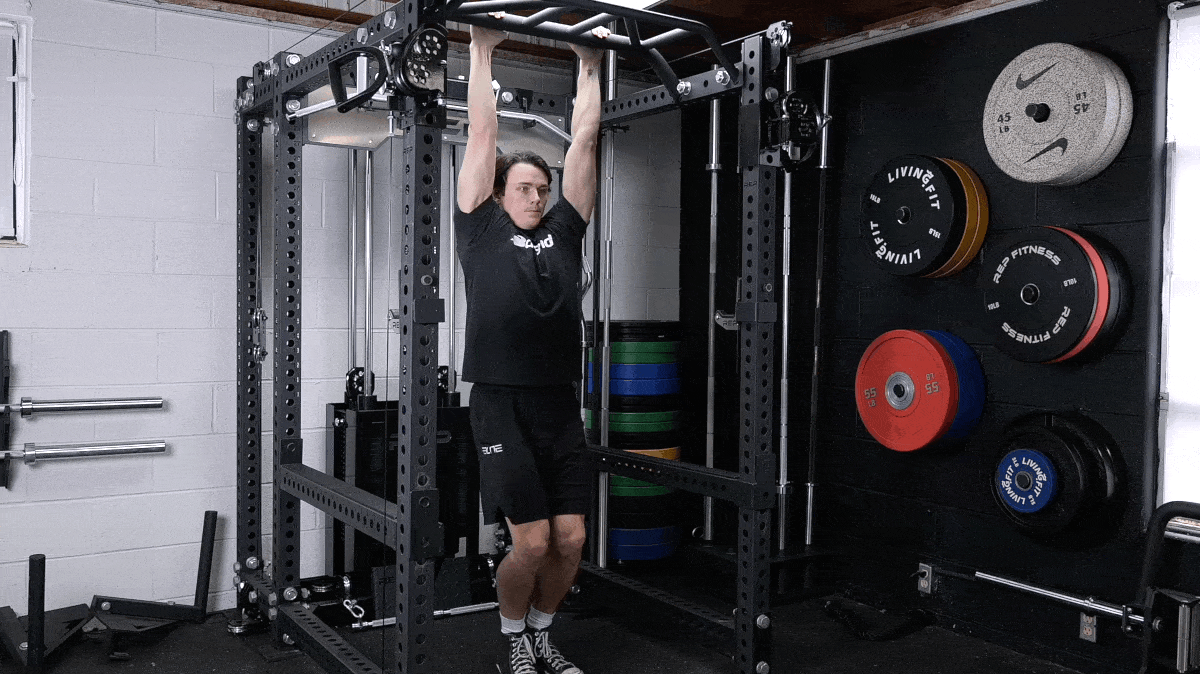
| Equipment Needed | Captain’s chair or pull-up bars |
| Muscles Worked | Abdominals, hip flexors, rectus femoris, upper back |
| Sets & Reps | 2-3 x 8-12 |
“There may not be a better all-around core exercise for your lower abs than the hanging leg raise,” Dickson notes. He’s right — we love hanging leg raises because they force your lower abs to contract hard to pull your legs upward. If you do these while hanging from a pull-up bar (we strongly recommend using lifting straps to help your grip), your core needs to work even harder to keep your torso motionless.
How To Do It
- Sit into a Captain’s chair station or hang from a secure pull-up bar with your legs extended below you.
- Brace your core, exhale, and lift your feet up and in front of your body until your legs are parallel to the ground.
Modifications
- Make It Easier: Bending your knees to 90 degrees artificially “shortens” your legs, making the move easier on your core.
- Make It Harder: Do hanging leg raises while suspended from a pull-up bar instead of using a station with back support, or try pausing at the top of each repetition with your legs straight in front of you.
11. Cable Crunch
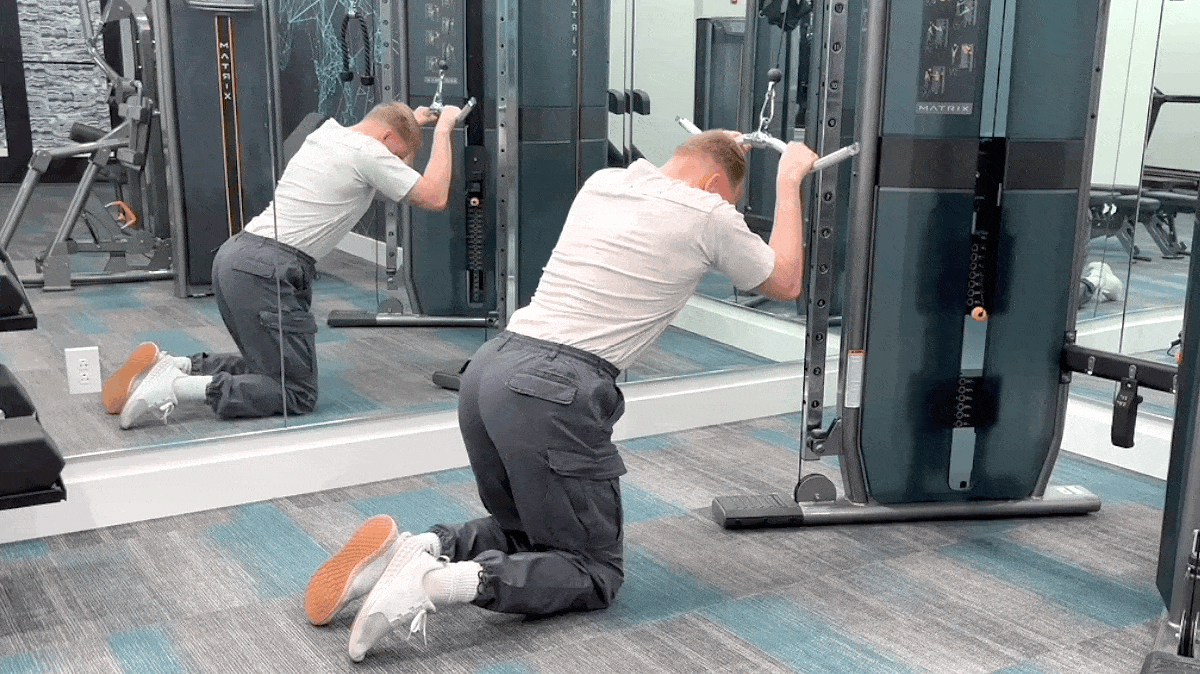
[Read More: The Best Cable Machines for Small Spaces, Bodybuilders, and More]
| Equipment Needed | Adjustable cable station, straight bar or rope attachment |
| Muscles Worked | Abdominals |
| Sets & Reps | 3-4 x 8-12 |
The cable crunch is one of our favorite core exercises. When it comes to training your abs for hypertrophy or if you’re a bodybuilder, it’s second-to-none. “The cable crunch lets you work your abs through their entire range of motion against consistent resistance. It’s unparalleled in that regard for targeting your six-pack for growth and tone,” Dickson mentions.
How To Do It
- Set an adjustable cable station pulley to around eye level and fix either a straight bar or rope attachment to it.
- Kneel in front of the cable station, gently holding the attachment with your arms bent at about a 90-degree angle.
- In the starting position, arch your back hard and poke your butt out to lengthen your abs.
- Exhale and curl over, deliberately rounding your spine and pulling your shoulders toward the floor.
Modifications
- Make It Easier: Try this move with a resistance band instead of a cable. This reduces the load and provides better tactile feedback so you can learn correct form.
- Make It Harder: Try the reverse cable crunch. Face away from the cable stack with the attachment behind your head to place more stretch on your abs.
3 Core Workouts To Try
We may have the best core strengthening exercises out there, but ab-training moves are only as useful as the workouts you plug them in to. Want a core workout at home, or one that you can blast in 15 minutes at the gym? We’ve got you covered.
Core Warm-Up
Many of the best core workouts you can perform don’t necessarily require a robust warm-up, especially if they don’t have intricate techniques or involve free weights.
That said, you can always benefit by starting your core workouts with a solid general dynamic warm-up and, if desired, do a few breathing exercises to get in touch with your deep abdominal musculature:
- 5 to 10 minutes of low-intensity cardio.
- 2 to 3 rounds of dynamic hip and shoulder stretching if desired.
- 2 or 3 rounds of five slow, deep belly breaths.
Core Workout for Beginners
If you’re new to fitness, you’re in luck — many of the moves on this list represent some of the best core exercises for beginners. Here’s an easy-to-perform, basic ab and core workout you can do just about anywhere:
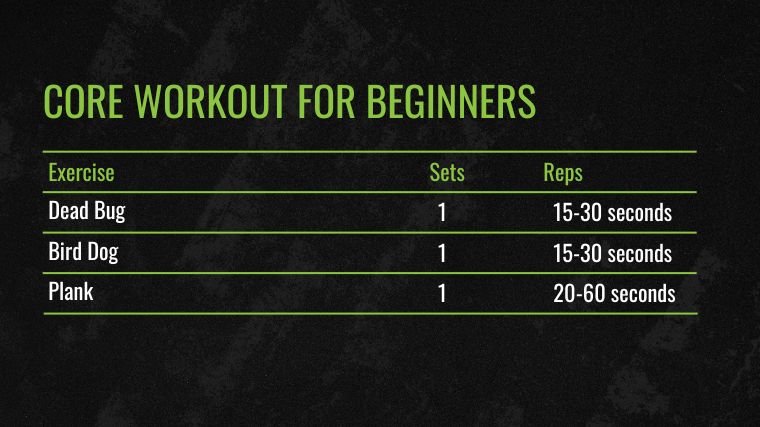
- Dead Bug: 15-30 seconds
- Bird Dog: 15-30 seconds
- Plank: 20-60 seconds
Perform these three exercises back-to-back as a circuit. Rest for 2 to 3 minutes between rounds and perform 5 rounds in total.
Core Workout at Home
Your core is one of the easiest muscle groups to train at home, since you don’t need complicated equipment. You can even fashion some weighted core exercises out of items you probably have around the house. Here are some of our favorite at-home core exercises packaged into a workout:
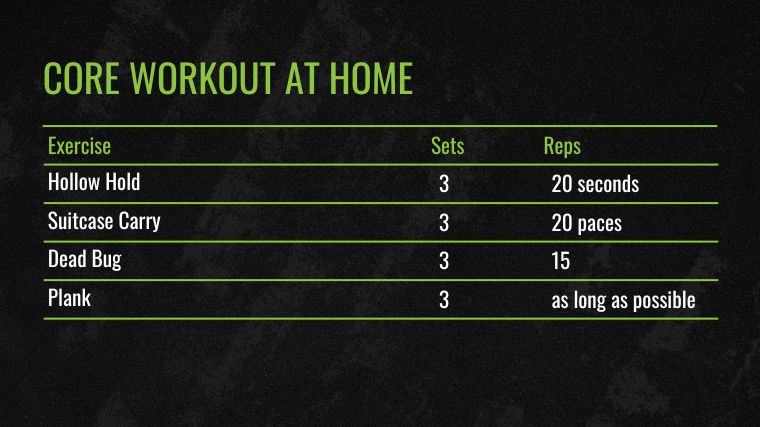
- Hollow Hold: 3 x 20 seconds
- Suitcase Carry: 3 x 20 paces
- Dead Bug: 3 x 15
- Plank: 3 x as long as possible
[Related: The Best Bodyweight Exercises You Can Do]
Core Workout for Back Pain
Make no mistake — no individual workout will cure an acute or chronic injury, especially when it comes to your back. That said, we know how potent core workouts can increase strength in your surrounding muscles. This is the best core workout because it’s lower-back-friendly and should help you build stability and security if you have back pain.
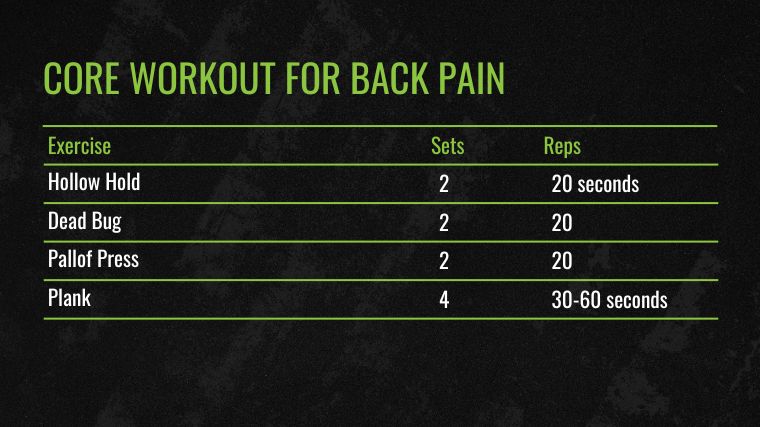
- Hollow Hold: 2 x 20 seconds
- Dead Bug: 2 x 20
- Pallof Press: 2 x 20
- Plank: 4 x 30-60 seconds
[Related: The Best Glutes Exercises for Back Pain]
Benefits of Training Your Core
The core exercises above train the muscles in the pelvis, lower back, hips, and anterior core to work together. This leads to better balance, stability, and strength — whether on the playing field or doing yardwork. Core exercises for lower back pain and high performance output alike both offer the following benefits:
Better Strength Performance
For the powerlifter or strength athlete who puts tremendous compressive and shearing forces on their spine, having a strong core helps keep the spine neutral. Plus, a strong and stable core helps transfer power from the lower to upper body more efficiently.
“The beautiful thing about lifting weights is that most movements inherently train your core,” Meier remarks. “However, having a strong core complements [strength training]. Losing core tension can lead to a missed lift, pounds left on the table, or, at worst, an injury.”
Everyday Endurance
Having a stronger core with more endurance allows you to do more work with less discomfort. Because it sucks when pain stops you in your tracks.
Strengthening your core muscles will go a long way in helping to reducing or preventing low back pain and keeping you on the field for longer. Further, training your core stability and endurance with the right exercises is one piece of the puzzle in reducing low back pain. (1)
Preventing Pain & Gaining Stability
Your core does much more than just look good at the beach. Your various abdominal muscles work together as a unit to stabilize your spine and prevent unwanted or errant movement. Therefore, including some core training moves in your routine on a regular basis may help prevent or manage back pain in some cases. (2)
How To Train Your Core
Most people begin their core training journey with some good old fashioned crunches or sit-ups. Those are fine movements, but there’s a wide world of core training out there — to make the gains you want, you need the right exercises in the right dosages.
Core Exercise Selection
Your core is a robust and diverse collection of muscles that perform some of the most important roles in your entire body. As such, the exercises you select to strengthen your midsection should apply directly to your goals. This idea holds true for core exercises for men and women alike.
For example, if you need more core endurance to perform your job or carry out manual labor, you may want to prioritize isometric exercises like planks, side planks, or loaded carry workouts.
[Read More: The Best Adjustable Dumbbells for Your Home Gym ]
However, if you want abs that really pop, you should emphasize flexion-extension movements like weighted crunches or ab rollouts (in addition to lowering your body fat through a calorie deficit). A well-designed, functional ab workout should house movements that challenge your midline in more than one way.
Core Sets and Reps
You can program core work before your lifting sessions to prime your body. You can also superset standard exercises with any of the core moves above. Lastly, you can end your training with them. But in general, core training follows the same broad set-rep prescriptions as any other muscle group:
- To Increase Strength: Perform loaded core movements for 3 to 5 sets of 5 to 10 reps.
- To Build Muscle: Perform dynamic core exercises that flex and extend your abs for 8 to 12 repetitions in most cases.
- To Gain Endurance: Perform isometric exercises and aim to hold a static posture for time for up to a minute or more.
Core Training Tips
Many go-to at home core exercises are simple in nature, but that doesn’t mean core training overall is. With so many muscles in play, you need to know how to maximize your core training to get the best results. Follow these training tips:
Prioritize Your Breathing
Your core contains many more muscles beyond the rectus abdominis that you can see in the mirror. Your deep abdominal wall, lumbopelvic complex, and groin are all lined by small — but essential — muscles.
Developing solid breathing patterns can help you turn these muscles on and get them in the game during your workouts. When you’re performing core exercises, focus on deep belly breaths and exhaling fully before recycling new air.
You’d be surprised at how much air you store in your body, and letting it all out will have your body shaking with effort.
Use Weight When Possible
Your core musculature supports you from sunrise to sunset from the moment you get up out of bed. However, the actual muscle tissue in your abs isn’t any different from anywhere else on your body.
Muscle hypertrophy and strength depends on progressive overload. Adding challenge to unweighted exercises is difficult as you get stronger. Eventually, to keep challenging you core, you’ll have to turn to external resistance to continue driving progress.
[Read More: The Best Bumper Plates on the Market]
If you’re comfortably blasting through dozens of rollouts or holding planks for multiple minutes, it’s probably time to start adding a bit of extra weight to your core training.
What Muscles Make Up the Core
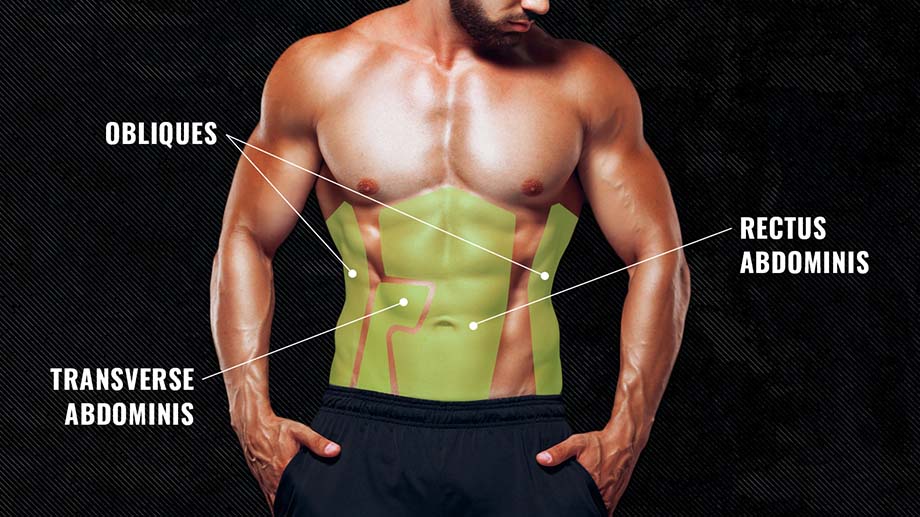
[Read More: The Best Ab Exercises, Plus 4 Ab Workout Routines From a Trainer]
Your core has multiple muscles and understanding what they are and how they function is important in obtaining a stronger and functional core. Here’s a breakdown of the major core muscles:
- Rectus Abdominis: Runs vertically up the front of the torso and is responsible for spinal flexion and anti-extension.
- Obliques: Consists of both the internal and external obliques and are located on the sides of the torso. Responsible for lateral flexion of the trunk and general torso stability.
- Transverse Abdominis: A deep muscle that sits underneath your rectus abdominis and controls pelvic stability and abdominal pressure.
- Hip Flexors: Play a key role in allowing you to perform compound hip-based exercises like squats or deadlifts. They sit at the front of your thigh and help you bend at the waist.
- Spinal Erectors: Your lower back muscles help stabilize your torso and bear the brunt of most spinal loading, especially during hinge-based exercises.
How To Engage Your Core
To train your core properly, you need to know how to use it in the first place. Luckily, your core is pretty simple to activate once you understand your anatomy.
Think of your core as two vertical structures; your hips and your ribs. It is the role of your core musculature to “square” them by clamping your ribcage down and pulling your pelvis into a neutral position.
To replicate this posture, try this simple sequence:
- Lie on the floor on your back with your knees bent and your feet on the ground.
- Tuck your pelvis posteriorly by squeezing your glutes slightly.
- Exhale fully to let out all the air in your trunk. At the same time, think about compressing your ribcage.
- Your lower back should fall flush against the floor. Once your entire back is in contact with the ground, squeeze your abs.
More Training Content
Now that you have a better handle on the best core exercises to strengthen your core, help crush PR’s, and help keep low back pain at bay check out these other helpful core training articles.
- Core Training for Olympic Weightlifters and Fitness Athletes
- Should You Train Core Daily?
- The Best Bodybuilding Ab Workout You Can Do
Frequently Asked Questions
How often should you do core exercises?
You can train your core between two and three times per week if you perform challenging exercises or use weights. That said, there’s no harm in doing basic, unloaded moves like bird dogs or dead bugs daily, as long as you don’t perform so many sets that it interferes with your other workouts.
How long should a core workout be?
A good core workout shouldn’t take much longer than 15 to 30 minutes. To improve the efficiency of your session, collect all the equipment you’ll need in advance, or pair exercises together that you can perform one after the other in the same location or with the same items — think of doing cable crunches and then Pallof presses, for example.
What is the fastest way to build your core strength?
You can strengthen your core the same way you’d build up any other muscle group; by using progressive overload and challenging your muscles over time. For the core specifically, you can also graduate from “basic” moves like the dead bug to similar, harder exercises like the bear crawl, and then introduce a bit of external load to push things even further.
How often should I do core workouts?
Some people say you can train your core every day, but we disagree. Your abs are a muscle like any other — if you train them properly, especially if you use external weights, your ab muscles will need time to recover. If you only do bodyweight core workouts, you can probably hit those muscles 3 or 4 times a week. If you like to do weighted core exercises, keep it to two weekly sessions.
References
- Abdelraouf OR, Abdel-Aziem AA. THE RELATIONSHIP BETWEEN CORE ENDURANCE AND BACK DYSFUNCTION IN COLLEGIATE MALE ATHLETES WITH AND WITHOUT NONSPECIFIC LOW BACK PAIN. Int J Sports Phys Ther. 2016 Jun;11(3):337-44. PMID: 27274419; PMCID: PMC4886801.
- Chang WD, Lin HY, Lai PT. Core strength training for patients with chronic low back pain. J Phys Ther Sci. 2015 Mar;27(3):619-22. doi: 10.1589/jpts.27.619. Epub 2015 Mar 31. PMID: 25931693; PMCID: PMC4395677.